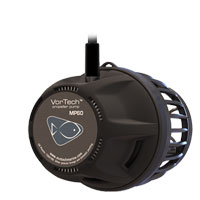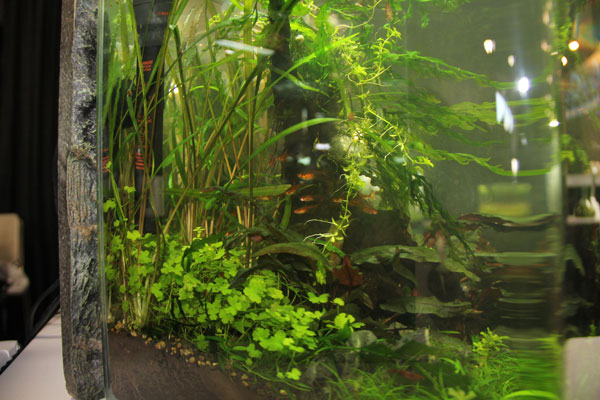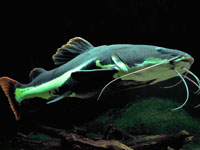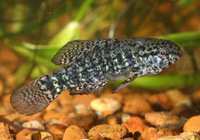
The year was 1987. Every Wednesday I would visit one of the larger wholesalers to purchase fish for the tropical fish store I then co-owned. I would look over each tank in my search for oddities and for fish that looked to be in excellent health. I often handpicked each fish that I would later sell.
During one such week there was a couple of tanks containing strikingly colored brown discus (Symphysodon aequifasciata axelrodi). They were often called candy-faced discus back then. The use of fancy names to make discus more salable is not a recent occurrence as many believe; it goes back decades.
The discus were half-grown. Their bodies were reddish-colored and their faces were bright-blue. They were striking and apparently selling fast, even at a price tag of $29 each — a huge sum considering that importers in Florida sold adult wild discus for as cheap as $6 at the time.
I kept walking and was soon approached by another store owner who could not believe the colors. I explained that those discus tints would soon fade. They had been treated to make their colors so vivid. He did not believe me. Weeks later, I received the fish. They looked like typical brown discus and were only occupying valuable selling space in a large tank.
Food Coloring
Feeding discus food designed to add coloration is fairly common. Additives like paprika, beet juice, shrimp or lobster roe, ground marigolds, astanxanthin and other high-carotene foods are commonly mixed with prepared foods to induce red coloration.
The effect on discus can be startling. A rather dull discus fed food containing astanxanthin can appear tomato red. The same effect can be derived by feeding discus the eggs of the shrimp Macrobrachium sp. as Jack Wattley documented in his Handbook of the Discus:
“Several years ago I had a female discus that laid bright red eggs and nearly all of them were fertile. No, the fish was not a true red discus; it was nothing more than a Symphysodon aequifasciata axelrodi (brown discus) that I had bought in Thonburi, Thailand. The fish had been fed freshwater shrimp eggs (Macrobrachium), thus making it red in color. The color of the fish and the subsequent eggs lasted for approximately three weeks, after which all red coloring gradually faded away.”
Color-fed discus fish will require foods with the coloring agent as part of the daily diet or they will slowly fade. Many prepared foods currently on the market are sold as “coloring foods” because they have these agents incorporated. Use of these foods does not appear to have any ill effects.
Hormonal Methods
Hormones have long been used to induce color in fish. Early in the hobby guppy breeders commonly used them to bring out the color in females, allowing them to be selected for line breeding. A colorful female, it was believed, would engender colorful males. This fact is well-documented.
Mervin Roberts’ book, Fancy Guppies published in 1957, discussed the views of various top guppy breeders of the time, such as William Sternke, Paul Hahnel and Frank Alger. Alger even discussed how he prepared his hormones, as follows:
1) Dissolve one-tenth of a gram of methyl testosterone in one half cup of 70 percent alcohol.
2) Transfer the alcoholic solution to a quart bottle.
3) Fill the quart bottle with water and shake well. This will be the stock solution.
4) For every 3 gallons of water, add six drops of the stock solution every other day.
The treatment was recommended to last no more than four weeks to bring out hidden colors. For a long time breeders — and dealers in Asia particularly — have used hormones to make discus more sellable; I recall seeing hormone-treated young discus in 1973.
Coloring Perceptions
Many will question why hormones are used to color fish. One can understand at least partially why this occurs. Young discus are drab little fish. The pigeon blood and related strains are slightly more attractive, but they are still rather unimposing to most.
The average person entering a pet store would simply walk right past their tank unless they were specifically interested in discus. By making them colorful, they can compete with the other gaudy fish for buyers. Asian dealers are aware of this. Their objective is to have dealers sell as many young as possible so that they continue to order their fish.
Some breeders also sell color-treated and hormone-altered discus as their own. In almost all cases such fish are Asian imports. No breeder that produces excellent quality discus will need to resort to such gimmicks to sell their fish. They will have willing and able buyers that understand discus are like flowers — they will blossom into “king of aquarium” fish slowly.
Faded Color
The problem is that hormone-treated fish will fade unless the hormone continues to be added to the water. But prolonged hormone use can possibly have deleterious effects. For example, in female guppies it can cause sterility.
Customers who expect a fish to keep its bright coloration often become disillusioned with each passing day as the fish becomes duller without continued hormone treatments. Many aquarists come to the conclusion that they have been taken. This is not necessarily so. The problem is that many dealers are not educated on the subject, and they fail to inform their customers.
Hormones are not entirely bad. They can induce adult color in young fish, allowing selection for future breeding. For example, hormones cannot induce a blue color that the fish will not have as an adult. The problem is that the overuse or prolonged use can have negative effects on the fish, including sterility. Fortunately, most dealers are aware of this and stop before irreparable damage occurs.
Complications
Hormones are considered controlled substances, meaning they need to be handled with care and used under strict guidance — a fact not widely understood. This is probably the reason why United States and European breeders do not use them. In Asia they are not as controlled and are handled freely. This leads me to worry about the health of hatchery workers overseas.
My views on hormone use are mixed. Hormone-treated discus can bring new aquarists into the hobby. Aquarists jump when they see bright little fish swimming around a dealer’s tank. If the dealer informs a buyer of the hormone treatment, I don’t think any fraud is committed. I do have a problem when a buyer is told the hormone-treated discus’ color will not fade. Their hormone-induced coloration will fade, even though as they grow their natural colors will appear.
The solution then is to educate hobbyists about discus color. If everyone works toward this goal, there may come a day when discus will be purchased with the expectation of their future color.
 EcoTech Marine, Eheim, and Rolf C. Hagen (USA) Corp. Win Pet Product News International Editors Choice Awards
EcoTech Marine VorTech MP60.
Eheims Aquastyle Aquarium.
EcoTech Marine, Eheim, and Rolf C. Hagen (USA) Corp. Win Pet Product News International Editors Choice Awards
EcoTech Marine VorTech MP60.
Eheims Aquastyle Aquarium.
 Fish Aquarium Setup Decorations
Few things are as captivating as a beautifully decorated aqu
Fish Aquarium Setup Decorations
Few things are as captivating as a beautifully decorated aqu
 Innovations in the Aquarium Hobby
Fishkeeping has experienced a lot of progress throughout the
Innovations in the Aquarium Hobby
Fishkeeping has experienced a lot of progress throughout the
 Red-Tailed Catfish in Home Aquariums
Q. The owner of my local fish store (LFS) sold me a red-tail
Red-Tailed Catfish in Home Aquariums
Q. The owner of my local fish store (LFS) sold me a red-tail
 Pygmy Sunfish
With this installment of Conservation Corner, I thought Id t
Pygmy Sunfish
With this installment of Conservation Corner, I thought Id t
Copyright © 2005-2016 Pet Information All Rights Reserved
Contact us: www162date@outlook.com